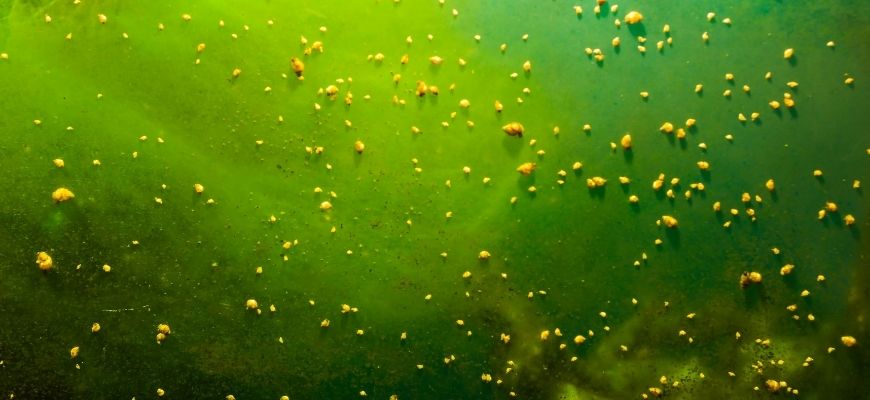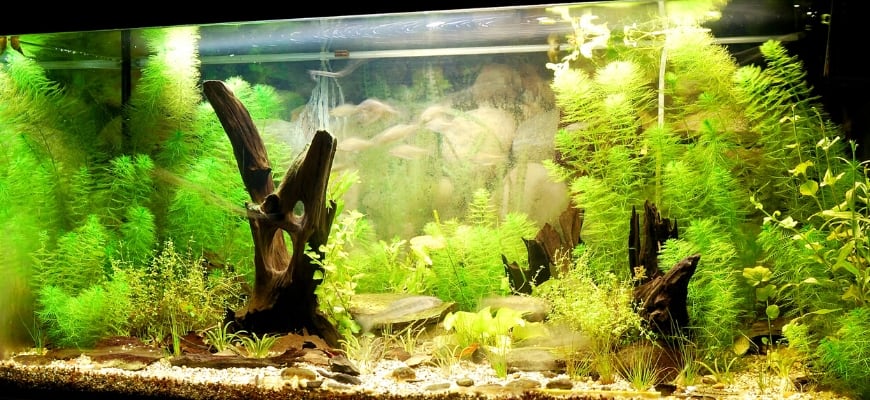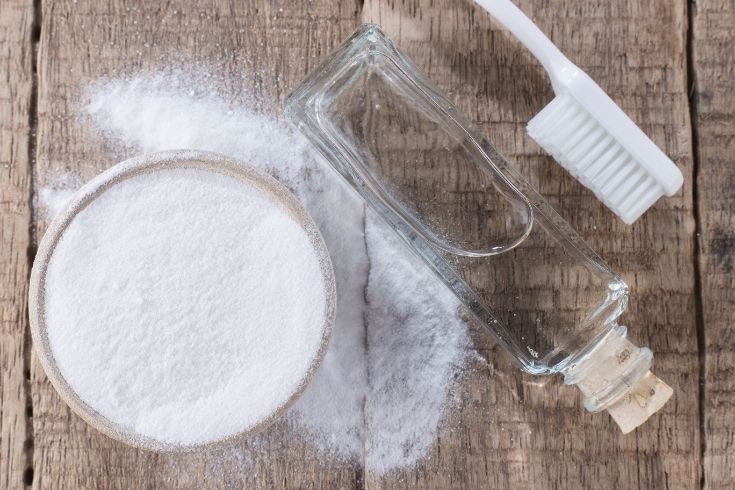How Do I Fix Green Aquarium Water
It can be a shocking and unnerving experience to walk by your beloved fish tank and find that the h2o has turned greenish. Non merely is dark-green water unsightly, but yous're also left wondering how it happened, and what it means for your fish. Feeling concerned is natural, but we're here to tell you not to panic!
With a niggling investigating, you'll soon effigy out what turned your h2o greenish. And with minimal to no effort, y'all'll be able to get your tank running smoothly once once again! This commodity explains why your one time crystal-clear water has changed color and what you tin do to fix it.
What Causes Green Aquarium Water?
Simply put, green aquarium water is caused by algae blooms. Almost aquarists may already exist familiar with the term, just permit's take a closer look at what it means.

Algae is a catchall term for a type of simple, photosynthetic, and more often than not aquatic plants that lack stems or roots. There are over 70,000 types of algae, and many of them occur naturally in freshwater tanks. Phytoplanktonis a type of algae that is responsible for turning tank h2o greenish.
A controlled population of phytoplankton is harmless and fifty-fifty beneficial to your tank. In fact, many hobbyists even add together phytoplankton cultures to their tank! Even so, certain conditions tin can trigger them to multiply exponentially, causing a free-floating algae bloom. Large quantities of suspended algae lowers the transparency of aquarium h2o and causes information technology to appear green.
Why Do Algae Blooms Happen?
Now that nosotros've established that green aquarium water is acquired by an algal flower, allow's delve into why your tank is turning into the color of pea soup. These factors provide a conducive environment for phytoplankton to multiply, which results in green-colored water.
This phenomenon initially poses no damage to your fish, but will wreak pregnant havoc if left untreated – making this more just an aesthetic upshot.
The initial surge of phytoplankton will likely not cause an result if you remedy information technology immediately. However, one time they die, they become food for decomposing bacteria, who will apply upwards oxygen in the tank for this purpose. This will in turn lower oxygen levels in your tank and harm your fish.
Given the potentially harmful implications of algae blooms, aquarium owners are ofttimes curious about how to forestall them in the first place. Let'due south take a wait at the 2 key reasons algae blooms happen:
Excess Light

The number ane cause of regular water turning green is excess UV lite – either from aquarium lights, or from direct sunlight. Too much exposure to low-cal can crusade phytoplankton to multiply exponentially in your tank, every bit they can at present perform photosynthesis at a greater rate.
Photosynthesis provides the suspended algae in your tank with more nutrients, allowing them to abound and reproduce more quickly. When they are present in large quantities in your tank, they turn your aquarium water green.
If you lot've determined that sunlight is the crusade of your issues, consider repositioning your tank so that information technology does not receive too much sunlight in the daytime. And if your tank light is the culprit, consider using a timer so that your tank only receives light during a specific period of time. Being able to control how much lite your tank receives will minimize the risks of green h2o outbreaks.
Likewise Many Nutrients
Too much of a good thing tin can indeed be a bad thing. Most plants rely on nitrogen and phosphorus for their nutritional needs, so these compounds are beneficial in moderate quantities.
Still, when nitrate and phosphate levels are besides high, they create conditions that cause algae to grow excessively, resulting in green water.
These nutrients typically originate from fish waste and excess food, merely they tin can sometimes occur equally a result of nutrient-laden tap water. Therefore, testing is primal. Perform regular water tests and to ensure that phosphate and nitrate levels are normal.
In addition, regular tank maintenance tin prevent fish waste product and uneaten food from building up. Performing a water change of 15-xx% once in 2 weeks can get a long way!
How To Ready Green Aquarium Water
Proper maintenance lies at the heart of every green water handling. Considering the root cause of this issue is backlog algae, fixing the trouble has a lot to do with making sure that tank parameters and lighting levels are as close to optimum every bit possible.
Merely put, the goal is to correct excessive levels of lite, nitrates and phosphates. Here are a few things you tin can practice to a greenish, murky mess into crystal-clear aquarium water!
Go on Your Filtration Organization Running Smoothly
Your filter is your best friend in the fight confronting green water algae as it can go on nitrate and phosphate levels nether command. Most filters comprise activated carbon which neutralizes dissolved organics, ridding your tank of the organics which cause algae to flower.
This all sounds amazing, just odds are, nigh tanks that turn green already accept a filter. Then what gives? Well, for one, you need a clean filter for it to work. This ways changing filter cartridges monthly, scheduling filter cleanings monthly, and making certain you perform regular filter maintenance.
Choosing the Right Filter
The 2nd thing y'all demand to do is brand sure that you have the correct filter type for your tank. Power filters and canister filters are most commonly used, then information technology can be helpful to weigh your options between the two past comparing their differences. Nevertheless, diatom filters are especially worth because if y'all have a green water problem, as they are capable of removing diatomic algae from the organization.
Final only not to the lowest degree, you demand to get a filter with the correct capacity. Choosing the correct filter capacity for large tanks is especially important considering a filter that is too small will not have the power it needs to role effectively. Meanwhile, if your filter is as well strong for your tank size, you hazard creating h2o currents that are too stiff for your fish, creating a less-than-ideal habitat.
In short, keeping your filtration organisation running smoothly is a matter of maintenance, as well as choosing the right size and type of filter for your tank. Check these boxes, and yous'll find yourself with clearer water in no time!
Consider Using An UV Sterilizer
What exactly is an ultra-violet sterilizer? UV sterilizers are popular amid aquarists because they effectively rid the h2o of free-floating microorganisms such as parasites, bacteria and algae. These sterilizers come up equipped with a UV tube, through which h2o passes through.
UV sterilizers can help with greenish aquarium water as it kills free-floating algae by damaging their Deoxyribonucleic acid. This ways that almost of the phytoplankton causing green aquarium water will die when they come into contact with UV rays, making this an effective fashion to rid your tank of this problem.
Are UV sterilizers safe?
Despite the many benefits of this smashing piece of equipment, hobbyists may have several concerns. Firstly, they may wonder if beneficial leaner will be killed in the process. Afterwards all, if UV rays damage the DNA of single-celled microorganisms, wouldn't it also damage the bacteria that course the backbone of their tank'south biological filtration arrangement?
The good news is, most good bacteria aren't free-floating. They are typically found forth tank walls, among the substrate, or on the filters and sponges. While a small number of free-floating beneficial bacteria might exist harmed, its impact on the overall population volition be side by side to zippo equally the vast majority will be fastened to tank surfaces.
Another matter to notation is that UV sterilizers are perfectly safe for fish and invertebrates. Nonetheless, aquarium owners volition want to be very careful as they handle this equipment, as UV rays can cause damage to their eyes and skin. Ever refrain from looking directly at the tube, and be very careful as you are installing the equipment.
Chemical Treatments May Help
As a last resort, you may want to turn to chemical products for help. Chemicals may fix your greenish water, but it is important to note that they practise not address the root cause of the problem. In addition, they may take unintended side furnishings on your fish, plants, and water. Nevertheless, they are typically an effective solution when you are in a compression.
The near common type of chemical handling used to treat green water are algicides. These piece of work by killing the algae in your tank. However, every bit previously mentioned, they are an constructive, but short-term fix. Without addressing the underlying issues that caused algal blooms in the first identify, information technology is very likely that they will occur once more.
Does Chemical Filtration Count?
When chemical treatments are referenced, they typically don't include chemic filtration methods as part of the definition. Unlike chemical treatments, chemical filtration simply relies on chemicals to remove components that cause algae growth, such as phosphates and nitrates. Activated carbon and phosphate removers are normally used in chemical filtration methods.
Meanwhile, chemical treatments include chemicals that are specially formulated to kill algae. While effective, information technology is a type of poison and may have unintended consequences on the health of your tank and its inhabitants. Therefore, it is of import to dose accurately based on the volume of your tank, and avoid making it a become-to solution.
Chemic filtration and chemical treatments are typically used separately. Earlier administering any grade of chemical treatment to your tank, exist sure to remove all chemical filtration components.
FAQ
Is Greenish Water Bad For Aquarium?
Yes, green h2o is bad for your aquarium. When water transparency is low, aquatic plants are unable to get the sunlight they demand to perform photosynthesis. This volition affect the health of your aquatic plants.
In addition, the presence of algae may reduce the corporeality of dissolved oxygen in your tank. This happens in two ways. Firstly, algae will conduct out aerobic respiration at dark, which requires oxygen. This makes oxygen more than scarce at night. Secondly, algae that die will be decomposed past leaner that use upwards oxygen in the process.
Both these factors reduce the oxygen concentration in your tank. Fish that do not have sufficient admission to oxygen may suffocate to decease in severe cases, or suffer from stunted growth in mild instances. Either way, fish keepers should practice all they can to prevent algae blooms in their tanks.
Will Vinegar Kill Algae In Fish Tank?
While vinegar can be used to remove algae from the tank, they do not exercise so by killing the algae.

Vinegar is typically used to wipe down the surfaces of fish tanks as they are natural and fish-condom. Since conventional cleaners such as soap can't be used on fish tanks, vinegar is seen as the perfect substitute. This means that a lot of the fourth dimension, vinegar is used to remove algae growth from tank walls and plants.
Unfortunately, this is not a feasible solution for green tank water, which are acquired by free-floating algae instead of algae that are attached to surfaces. Simply dosing your tank with vinegar will not fix the problem.
How Long Does Information technology Have for UV to Articulate Green Water?
The reply to this question depends on the size and strength of your sterilizer. However, nearly of the costless-floating algae causing green h2o should exist removed in under 48 hours.
Is Light-green Algae Skillful for Fish Tanks?
In small, controlled quantities, greenish algae is really skillful for fish tanks every bit they tin can be a reliable food source for many underwater sea creatures. Even so, they are harmful in big, uncontrolled quantities every bit they will lower the oxygen concentration of your tank.
Conclusion
If you discover yourself with a tankful of greenish h2o, it can be natural to panic and scramble for a solution. Frankly speaking, however, panicking doesn't help the situation. Dark-green water is caused past two key factors – lite and nutrients, which are relatively piece of cake to fix. As long equally yous remain methodical in your approach, you should exist able to set up the situation in side by side to no time!
Did yous savour this article? If y'all did, don't forget to share it with a friend who will benefit from the insights outlined here! Have you ever dealt with a green h2o outbreak yourself? We'd also dearest to hear from y'all! Simply talk to us in the comments below!
How Do I Fix Green Aquarium Water,
Source: https://www.tankarium.com/aquarium-green-water/
Posted by: scottwhaption.blogspot.com


0 Response to "How Do I Fix Green Aquarium Water"
Post a Comment